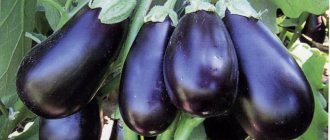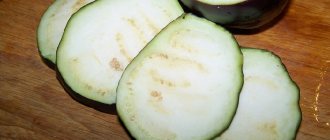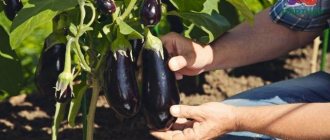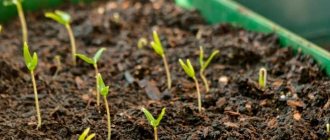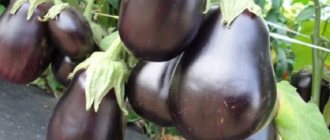Eggplant Andryusha F1 is an early-ripening hybrid from an agricultural company specializing in breeding new types of vegetables and flowers. According to many gardeners, it is one of the best and shows high productivity even in unfavorable seasons for the crop. Andryusha's eggplant is also valued for its high taste, since its pulp contains a minimal amount of seeds and is never bitter. But in order for the hybrid to show high, stable yields, it is necessary to plant it correctly and follow the recommendations for caring for the plants in the future.
Andryusha eggplant is suitable for open ground and greenhouses
Description and characteristics of eggplant Andryusha F1
The hybrid differs in the appearance of the bushes, fruits and characteristics. To successfully grow it and regularly get a harvest, you need to study these features in advance. This information will also allow you to find out how productive Andryusha’s eggplant is in comparison with other types of crops.
Appearance
The hybrid is characterized by semi-spreading bushes, which are recommended to be formed into three stems, which guarantees high yield and excellent quality of fruits. The height of the plants reaches 90-100 cm. The stems and petioles have an anthocyanin tint.
Trending Pilaf with chicken and shrimp
The plates of the variety are large, shaped like oak leaves, up to 25-30 cm long. They are dark green in color, smooth on top, and pubescent on the back side. Large flowers are collected in inflorescences of 2-3 pieces. When opened, the buds have a light purple tint.
When ripe, the fruits of Andryusha eggplant are dark purple in color with a smooth shiny surface. They grow up to 30 cm long and about 7-10 cm in diameter. The average weight of hybrid eggplants ranges from 200-300 g. Their shape is leveled, elliptical, slightly expanded at the top. The skin is thin, evenly colored. The pulp is white with a small amount of seeds. It has an elastic consistency.
The hybrid has an accelerated growth rate
Taste and purpose
Andryusha eggplant fruits have a pleasant sweetish taste and retain it at any period of ripening. The variety is suitable for preparing caviar, salads, stewing, pickling, and baking. During heat treatment, the pulp retains its consistency.
Important! The fruits of the hybrid do not require pre-soaking in salted water, as they do not contain bitterness.
Ripening time
Andryusha eggplant is a mid-early crop. The duration of its growing season is 100-110 days. The first fruits on the bushes appear in early July, subject to the seedling method of growing the hybrid.
Eggplant productivity Andryusha
Andryusha eggplant is characterized by high productivity, which is due to a long fruiting period of 3.5-4 months. Subject to the rules of care, the volume of harvested fruits per 1 sq. m reaches 7-10 kg.
Important! The yield of a hybrid when grown in open ground can be higher than in a greenhouse.
Growing regions
Andryusha eggplant is suitable for growing in all regions of the country. In the southern and central regions, planting in open ground is recommended, and in the northern regions - in greenhouses. The hybrid tolerates temperature changes well without loss of productivity.
When to sow seedlings?
In recent years, many new varieties and hybrids of eggplants, unusual in shape, color and size, have appeared.
If you love this vegetable, then try growing 'Andryusha F1' with me next year. I advise you to purchase seeds in advance so that you can sow them in early March and plant the seedlings in open ground under primitive shelters in mid-May. If you decide to grow eggplants in reliable greenhouses, then prepare 70-day-old seedlings for earlier planting dates, say, in the third ten days of April - early May. In conclusion, I suggest you watch a video about the beautiful eggplants in our beds. Read about preparing the nutrient substrate, soaking the seeds before sowing and further caring for the seedlings in the publication Growing eggplant seedlings: what you should pay attention to. We also recommend waiting for new articles in which the General Director of Agro will talk in detail about the golden rules of growing excellent eggplant crops. Nikolay Petrovich Fursov, agricultural expert
Advantages and disadvantages
Andryusha's eggplant has many advantages, which is confirmed by reviews from gardeners. But it also has certain disadvantages that need to be taken into account.
The hybrid has high life potential
Interesting on the topic:
Apple tree variety Black Diamond: description and photos, reviews
Mar 3, 2022
Beijing cabbage Cha-Cha: growing and caring for outdoors...
Mar 2, 2022
Main advantages:
- good yield;
- stable fruiting for four months;
- early ripening;
- unpretentiousness to growing conditions;
- resistance to temperature changes;
- immunity to viral diseases;
- large fruit;
- lack of bitterness;
- low seed;
- accelerated growth rate.
Flaws:
- susceptible to drought;
- needs good lighting;
- requires regular feeding.
Growing seedlings
It is recommended to grow Andryusha eggplant using seedlings. At the time of planting in a permanent place, seedlings should be 65-70 days old. Therefore, it is recommended to sow seeds at home at the end of February, at the beginning of March.
For planting, it is necessary to prepare wide containers up to 10 cm high with drainage holes. They need to be filled with a nutritious soil mixture consisting of turf, sand, peat and humus in a ratio of 2:1:1:1. It is also recommended to additionally add perlite to the substrate at the rate of 0.5 liters per 10 liters of soil and mix thoroughly.
Two days before planting, the soil must be disinfected. To do this, you need to pour it with a solution of Fitosporin, and then dry it slightly. Before planting, moisten the substrate, compact it and level the surface. It is recommended to spread Andryusha eggplant seeds at a distance of 3 cm, and then sprinkle them with a layer of soil 0.5 cm thick. At the end of planting, the soil should be sprayed with a spray bottle, and then cover the container with film or glass.
The container should be moved to a dark place with a temperature of +23-25 °C. And after the emergence of friendly shoots, which happens on the 7-10th day, it needs to be moved to a bright windowsill and the maintenance regime reduced to +20-22 °C. This will curb excessive growth of the above-ground part and accelerate the development of the root system. Eggplant seedlings require standard care. After the seedlings have grown stronger, they need to be adapted to external conditions and the cover must be completely removed.
At the stage of two true leaves, eggplants must be planted in separate containers to build up a powerful root system. And 10-14 days after this, fertilize with complex mineral fertilizer intended for seedlings.
Andryusha eggplant seeds do not require pre-sowing preparation
Landing
The seed material is soaked for a day in warm water, then kept in an activator solution (Bioglobin, Epin). For seedlings, a nutritious soil mixture is prepared from turf and a compost-peat component. Vermicompost, ash, and phosphorus-potassium additive are added to it. Drainage is placed at the bottom of the boxes, then vermiculite and soil mixture. The optimal height of the containers is 8-10 cm. The seeds are placed at a distance of 3 cm.
The soil is disinfected with potassium permanganate, Trichodermin or any fungicide (dilution according to instructions).
At home, young bushes are kept for 60-65 days. With the onset of stable warmth, the seedlings are planted in permanent beds.
Sowing dates begin in early to mid-March. In the south, you can sow eggplants from the second half of February. Seedlings are planted from May when warm weather sets in - the temperature is 14-16 degrees.
The seedlings are watered with settled water, and the soil surface is kept moderately moist. Before the seedlings hatch, the containers are covered with film. Additionally, the bushes are illuminated with fluorescent lamps; the day length should be at least 10-13 hours.
Hardening on the eve of transplantation lasts 7-10 days. Seedlings are placed on a window or balcony, where the temperature is 5-7 degrees lower than in the room. At night the temperature is also lowered to 10-11 degrees. 3-5 days before replanting, the bushes are kept on an open balcony. At the same time, reduce the frequency of watering. For better adaptation, plants are fed with the following means:
- superphosphate;
- nitrophoska;
- saltpeter;
- potassium sulfate.
The placement density is up to 4-5 bushes per 1 m2.
Good precursors are cabbages of all types, greens, melons, and grains and legumes. It is recommended to plant garlic and onions nearby. Undesirable neighbors are potatoes and tomatoes. For beds, choose well-lit places without drafts. The soil should be light, with a neutral pH.
Transplanting seedlings into the ground
You can plant hybrid seedlings in a greenhouse at the end of April, and in open ground in early, mid-May. To do this, it is necessary that constant warm weather be established at +14-16 °C. In order for the seedlings to tolerate transplantation well and quickly adapt, they must first be hardened off. To do this, you need to start preparing a week in advance. For the first time, take the seedlings outside to a dark place for an hour, and with each subsequent day increase the time interval by another half hour.
Seedlings should be planted in holes with a ball of earth, without deepening them. The recommended planting scheme is four plants per 1 sq. m. After the procedure, water the seedlings generously.
Important! It is recommended to transplant to a permanent place in cloudy weather or in the evening.
Transplantation into the ground and further care
Despite his endurance, Andryusha F1 loves warmth and moisture. On the other hand, excessive heat leads to the fall of flowers, and temperatures below 12 degrees Celsius, which last for a long time, lead to a stop in growth and development.
Preparation for transplantation and hardening
Before planting on open ground, seedlings grown at home inside a greenhouse or greenhouse must be hardened off. About 14 days before transferring to the garden at night, it is recommended to reduce the temperature to 12-14 degrees Celsius. It is not recommended to harden the plant for a longer period, since in this case its development and growth will be inhibited.
3-5 days before planting in open ground, the temperature in the growing area must be brought to street levels. To do this, the seedlings need to be taken out to an open balcony or greenhouse transoms raised. It is advisable to close the windows at night if there is a threat of frost.
In parallel with the gradual decrease in temperature, the amount of watering should be reduced, adhering to their norm. Such measures allow you to dry the earthen lump of rhizomes. 1-2 days before moving outside, it is recommended to carry out hardening fertilizing with superphosphate, ammonium nitrate, and potassium sulfate.
Prepared seedlings more easily adapt to changed conditions, continuing active growth and development. Otherwise, it slows down for about a week.
Transplantation into the ground
Loose, well-permeable soil for moisture is optimal for this variety. It should be nutritious and warmed by the sun. It is these conditions that will ensure intensive, uniform growth and development of the rhizome, which is the basis of the future harvest.
It is better to arrange a bed for this vegetable crop in a well-lit place. This place should be placed away from tomatoes. Before planting, seedlings with formed buds need to be treated with care. It is necessary to loosen the soil of the pots very carefully so as not to damage the roots. The soil should not be allowed to dry out, and the plant should be watered abundantly before planting.
Scheme for planting eggplants in the ground
It is recommended to plant eggplants when they reach 70-80 days of stable heat. The seedlings are taken out of the cups along with a lump of earth and placed in deep holes with a gap of 30 cm between the bushes.
Watering
After planting in the holes, it is recommended to immediately water the eggplants. Next, the soil needs to be watered periodically, keeping the top layer moist. The first loosening of the soil should begin only after the second watering.
During weekly watering activities, the top layer should be loosened shallowly. The frequency directly depends on weather conditions. For example, if it rains often, then additional moistening is sufficient once every 10-12 days. In hot weather you will need 2-3 times a week.
Remember!
During the period of fruit ripening, the intensity of soil moisture increases.
Fertilizers
Before planting, it is better to enrich the soil by adding peat, sand, humus, and rotted sawdust. All components should be mixed thoroughly. This fertilizer should be added to the ground at the rate of one bucket per 1 sq.m.
In the future, it is recommended to use complex fertilizers for fertilizing. The soil should be fertilized with this set of microelements on an organic or mineral basis 1-2 times during the entire growing season.
Diseases and pests
You may be interested in: Favorable days for planting eggplants in the Urals and Siberia in 2022 Dates for planting eggplants for seedlings in 2022 according to the lunar calendar of gardeners and gardeners Picking eggplants for seedlings according to the lunar calendar 2022
Root rot often affects this variety of eggplant due to excessive watering. This leads to wilting, browning, and falling leaves. To prevent such phenomena, it is recommended to use a biological preparation based on Trichodermin mushrooms. Before the beginning of the fruiting period, the use of the drug Previkur is allowed.
Eggplant often suffers from Colorado potato beetle infestations. A mechanical way to solve this problem is to use a protective film. For example, plants are protected inside greenhouses. In such conditions, a powerful bush is formed even before the mass appearance of these pests. Beautiful dark fruits appear earlier without any chemical treatment.
When fighting beetles in an outdoor garden, it is recommended to use biological preparations such as Actofit, avoiding the use of pesticides.
Further care
Eggplant Andryusha needs regular watering in the absence of precipitation for a long time. For irrigation, you need to use settled water at a temperature of +20-22 °C. Watering is carried out at the root at the rate of 1-3 liters for each bush, depending on its stage of development. The frequency of moisturizing is 1-3 times a week. During hot periods, it is recommended to lay mulch at the base of the bushes to prevent excessive evaporation of moisture from the soil.
Caring for a hybrid involves pinching the bushes, which will redirect the plant’s forces to the formation of the ovary. You also need to periodically weed the bed with the hybrid and loosen the soil after each watering.
Andryusha's eggplant needs to be fertilized regularly throughout the growing season. The first fertilizing should be carried out ten days after planting the seedlings in a permanent place. For it you can use chicken manure 1:15 or mullein 1:10. In the future, you can use yeast, wood ash, and also use 30 g of superphosphate and 20 g of potassium sulfide per 10 liters of water. The frequency of application of fertilizers is once every two weeks.
Fertilize after watering or rain
Hybrid Andryusha is susceptible to late blight and various rots. Therefore, it is necessary not to ignore preventive treatments of bushes with fungicides. They need to be carried out three times at intervals of 10-14 days.
Reviews from gardeners about the eggplant variety Andryusha
Svetlana Portnova, Moscow I grow eggplant Andryusha at the dacha, where I can only visit on weekends. But even with minimal care it produces a generous harvest. Moreover, the bushes bear fruit until the end of October, if weather conditions permit. The hybrid is characterized by rapid growth; when planted in a permanent place, the seedlings easily adapt and develop fully. From each bush I get about 6-7 kg of fruits, which are excellent for preparing various dishes. Oksana Semenova, Kaluga I have been growing this hybrid for the last two seasons. I am completely satisfied with its productivity and unpretentiousness. The fruits of the Andryusha eggplant have an attractive appearance, elastic consistency of pulp, which contains very few seeds, and a sweetish taste. Therefore, they can be used fresh for adding to salads, as well as grilling and other types of processing.



